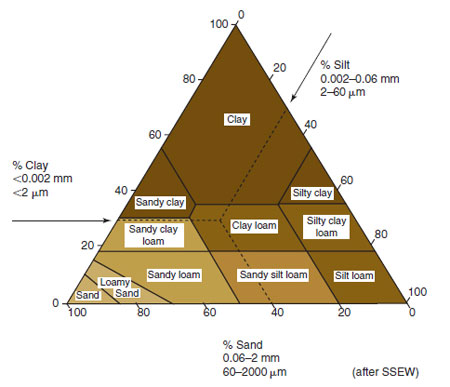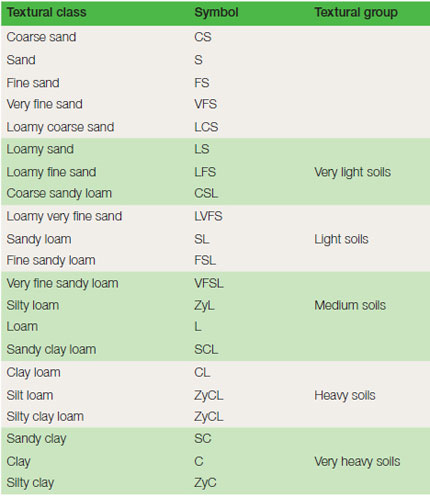Soil texture
ContentSoil texture describes the mineral composition of a soil. In most cultivated soils the mineral content forms the framework and exerts a major influence on its characteristics. Examples of different textures are given in Figure 17.11 . Texture can be considered to be a fixed characteristic and provides a useful guide to a soil’s potential. Fine-textured soils such as clays, clay loam, silts and fine sands have good water-holding properties, whereas coarse textured soils have low water-holding capacity but good drainage. This also means that soil temperatures are closely related to soil texture, because water has a very much higher specific heat value than soil minerals. Consequently freely draining, coarse sand warms up more quickly in the spring but is also more vulnerable to frosts than wetter soils.
Soils with high clay content have good general nutrient retention, whereas nutrients are readily lost from sandy soils, especially those with a high coarse sand fraction. The application rate of pesticides and herbicides is often related to soil texture. The power requirement to cultivate a clay soil is very much greater than that for a sandy soil. The expression ‘heavy’ for clay and ‘light’ for sandy soils is derived from this difference in working properties rather than the actual weight of the soil. The texture of a soil also influences the soil structure and soil cultivations. The addition of a calcareous clay to a sandy topsoil, a practice known as marling, can improve its water-holding capacity, as well as reducing wind erosion, but it requires the incorporation of 500 tonnes of dry clay per hectare to convert it to a sandy loam. The practice of adding clay is now largely confined to the building of cricket squares. To ‘ lighten ’ a clay loam topsoil to a sandy loam more than 2000 tonnes of dry sand is needed on each hectare (roughly the same volume of sand has to be added as the volume to be changed). The addition of smaller quantities of sand is often an expensive exercise to no effect; at worst it can make the resultant soil more difficult to manage. Texturing by feel A more practical method of determining soil texture, especially in the field, is by feel. This can, with experience, be a very accurate means of distinguishing between over thirty categories. A ball of soil about the size of a walnut is moistened and worked between the fingers to remove particles greater than 2 mm and to break down the soil crumbs. It is essential that this preparation is thorough or the effect of the silt and clay particles will be masked. The characteristics of the different mixtures of sand, silt and clay enable the texture to be determined:
Determining texture by feel has the limitation that the influence of organic matter and chalk cannot be eliminated. Chalk tends to give a soil a silky or gritty feel depending on fineness, but the fact that a soil is known to be chalky should not influence the texturing. Its textural class may be prefixed ‘calcareous’, e.g. calcareous silty clay. Organic matter tends to increase the cohesiveness of light soils, reduce the cohesiveness of heavy soils, and large quantities can impart a silky or greasy feel. The prefix ‘organic’ can be used for describing mineral soils with 15–20 per cent organic matter. Soils with 20–35 per cent organic matter are peaty loams, 35–50 per cent organic matter loamy peats and soils with greater than 50 per cent organic matter are termed peaty. Peats are almost pure organic matter (see organic soils). Mechanical analysis of soils Soil texture can be determined by finding the particle size distribution. There are several methods, but all depend on the complete separation of the particles, the destruction of organic matter and the removal of particles greater than 2 mm in diameter. Sieving can separate the stones, coarse sand, medium sand and fine sand fractions. Finer particles are usually separated by taking advantage of their different settling velocities when in suspension. The settling velocity of a particle depends on its density and radius, the viscosity and density of the liquid and the acceleration due to gravity; the method is simplified by assuming that soil particles are spherical and have the same density and the investigations are conducted in water at 20ºC. Particles that are less than 0.001 mm in diameter are kept permanently in suspension by the bombardment of vibrating water molecules and are referred to as colloids, e.g. most clay particles. All sand particles will have fallen more than 10 cm after 50 seconds, so a sample taken at that depth can be used to calculate the clay plus silt left in the suspension. Similarly, other fractions can be calculated until the sand, silt and clay are determined. The soil texture can be deduced from this information using a textural triangle (Figure 17.11), which is the basis of identifying soil types. |






